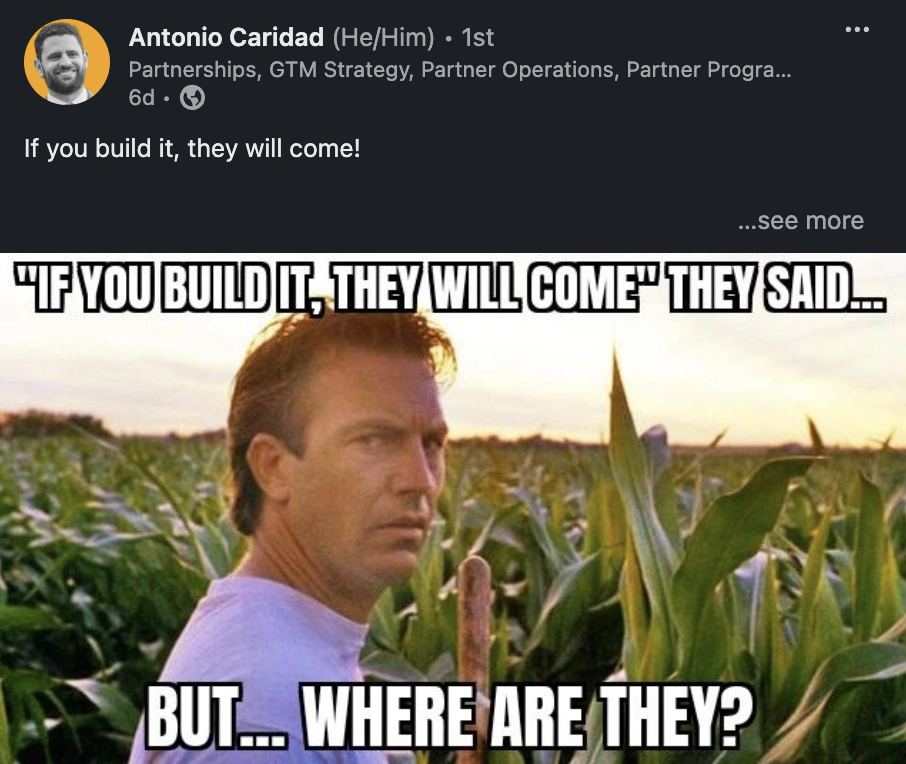The Nearbound Daily is now officially the ELG Insider Daily!
Welcome to the
ELG Insider Daily—the #1 newsletter in the world keeping thousands of GTM professionals on top of the latest Ecosystem-Led principles, tactics, and trends.
Join the movement here.
PRINCIPLES
Timing + Strategic finesse = A successful channel partner program
The timing of investing in a partnership program is critical to realizing its benefits and maximizing success.
But “the earlier the better” doesn’t fully apply to channel partner programs.
You have to start as soon as you are ready to initiate and invest in a formal partner and channel strategy (not before).
Build your channel partner program when the following elements are aligned to your partner motion:
- Your company’s market,
- product features,
- resources available,
- product-market fit, and
- the maturity of your go-to-market motions.
TACTICS
The 6 questions before launching your channel partner program
Many companies have seen success as they build their channel partner program—eBay, Oracle, and Microsoft. Let’s take Microsoft as an example: They are earning $32 billion in annual revenue from their SaaS partnerships.
But before you go and start looking for resellers, co-marketing partners, or distributors, ask yourself these 6 questions (shared by
Lisa Lawson,
Senior Analyst at
Canalys) :
1. Is there organic momentum from potential partners (and how active are potential partners in your ecosystem)?
Evaluate the level of external interest and activity from potential partners, such as system integrators (SI’s) and agencies servicing your target customers. If these partners are actively engaging and eager to collaborate, it's a strong indicator of organic momentum and the potential value of developing a partner strategy and program.
2. Are your preliminary TAM, CAC, and CRC metrics favorable?
Use industry research, historical sales data, and tools like Crossbeam and Reveal to measure the Total Addressable Market (TAM) for potential partners. Compare this TAM against your company's long-term scalability needs.
Then model the projected CAC and CRC for the channel, using market data and comparisons to direct sales metrics, to determine if these preliminary metrics are favorable for investing in a channel function.
3. Is my product ready?
As simple as the answer to this question can be, this goes far beyond a yes/no answer. You have to consider the following:
- Your product-market fit
- The readiness of your product/company to involve partners in your current processes
- The focus of your Product team is not on fixing basic and fundamental bugs
If your product isn’t ready, prioritize partnerships suited to its limitations, like an affiliate network, or delay investing in a partner program until it's more mature.
Channel partners will need to be able to use your product with minimal support across multiple clients.
4. Can my sales, customer success, and support processes be replicated by a third party?
To build a channel program or a network of resellers, you will need to have a replicable process to teach to a variety of external sales professionals. Why?
Besides channel partners distributing/selling your product, you will need to enable them how to support, service, and manage your clients post-sale.
The more repeatable your sales motion is, the more it lends itself to a successful channel program.
5. Do I have internal support and access to the cross-functional resources I need to make partners and a partner strategy successful?
Your channel partner program will need support from your Marketing, Sales, Product, Customer Success, Education, Operations, and Legal teams. Plus, you will need a budget, tech stack, and talent to manage your program.
6. What else could my company invest in right now if they didn’t invest in a partner strategy?
Here’s the best time to look for alternatives, consider the “opportunity cost” of building a channel partner program—the value of the next-highest-valued alternative use of that resource.
Do a thoughtful Buy vs Build vs Partner analysis. This will help you decide how to allocate resources and determine if it is best to build in-house, buy, or partner to take advantage of strategic opportunities.
FROM THE ECOSYSTEM
If you build it, they will come!
Your channel partner program will not succeed if any of the following aren’t ready: your company, product, or team. All three need to be prepared.
Building a partner program should never be thought of as a “test”— no matter how well-suited your product is for partners, it will take time to scale and see the benefits.

Stuff you don't want to miss!
- July 17th — GTMnow live event: Crossbeam and Reveal are joining forces: the merger and what it means for go-to-market and ELG. Join GTMnow/GTMfund VP of Marketing Sophie Buonassisi in conversation with Crossbeam CEO Bob Moore and Reveal CEO/now Crossbeam COO Simon Bouchez about how the merger will shape the future of ecosystems.
Register here. - July 18th—Extend HubSpot with G2 and 6sense: How B2B SaaS Companies Can Leverage Account-Based Strategies to Win—Tiphaine Amblard
(HubSpot),
Rachel Gianfredi
(G2),
Stephen Lackey
(SmartBug Media),
Jeff Wagner
(6sense), and
Jonathan Burg
(New Breed) on how you can better leverage the G2 and 6sense integrations to optimize your ABM strategy.
Register here.
You're all caught up
See you tomorrow
If this email was forwarded to you,
sign up here to get the newsletter every week.




